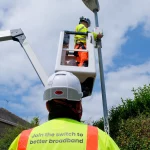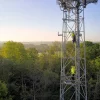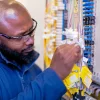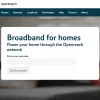Take-up Rises as Netomnia Report Q1 Results for UK 10Gbps Broadband Network

Alternative operator Netomnia (Brsk and YouFibre), which last week reported expanding their 10Gbps speed Fibre-to-the-Premises (FTTP) broadband network to cover 2.4 million UK premises (RFS) and connecting 310,000 customers (here), has today published their Q1 2025 results and seen take-up grow to 12.4% (up from 11.5% in Q4 2024).
The network access provider is now currently in the process of completing their merger with Brsk (here) and aims to expand their full fibre (FTTP) broadband network to reach 3 million premises by the end of 2025, which will be followed by 5 million come the end of 2027 (inc. 1 million customers by 2028). The service is currently available across parts of over 90 UK cities and towns.
The latest results for Q1 2025 represent slightly older data than some of the figures that were released last week as part of their £160m funding (debt) announcement (inc. an increased coverage commitment). But we also get some useful new updates on customer take-up, revenue, net debt and EBITDA (i.e. earnings before interest, tax, depreciation and amortisation).
Advertisement
The group is currently still expecting to achieve positive EBITDA in 2025. “We’re poised to reach 3 million premises serviceable and achieve EBITDA positivity in 2025. Our success is underscored by securing a £160 million junior debt facility, affirming our robust business model. In a UK market ripe for consolidation, we stand out as the premier platform to lead this transformation,” said Group CEO, Jeremy Chelot.
Key Figures from Netomnia’s Q1 2025 Results
➤ Revenue:
Q1 2025 Result: £19.9m (304% YoY increase)
Q4 2024 Full Year Result: £38.6m (321% YoY increase) – annual total
➤ Premises Serviceable:
Q1 2025 Result: 2.32m (up 239k in the quarter)
Q4 2024 Result: 2.08m (up 255k in the quarter)
➤ Premises Connected:
Q1 2025 Result: 288k (up 50k in the quarter)
Q4 2024 Result: 238k (171k added in 2024, 48K in the quarter)
➤ Take-up Rate:
Q1 2025 Result: 12.4% (up 9% Quarter-on-Quarter)
Q4 2024 Result: 11.5% (up 38% YoY)
➤ Adjusted EBITDA (excludes exceptional items):
Q1 2025 Result: (£5.3m) (up 21% YoY)
Q4 2024 Full Year Result: (£29.6m) – annual total
➤ Net Debt (debt drawn to date including accrued interest less cash.):
Q1 2025 Result: £610m (up 15% Quarter-on-Quarter)
Q4 2024 Result: £531m (up 223% YoY)
We note that Netomnia doesn’t shy away from proclaiming itself in the results to be the “UK’s 2nd Largest Alt-Net“, which is likely to remain true now that nexfibre seems to have taken a backseat with their own roll-out plans due to changes at Telefonica (here) – unless they go aggressive on their proposed talk of a consolidation drive. Meanwhile, CityFibre remains the largest alternative network with around 4.4 million premises passed (4.2m RFS).
UPDATE 8:43am
Just to clarify that the Q4 2024 figures were year-to-date for revenues and other financial figures, rather than quarterly.
Advertisement
Mark is a professional technology writer, IT consultant and computer engineer from Dorset (England), he also founded ISPreview in 1999 and enjoys analysing the latest telecoms and broadband developments. Find me on X (Twitter), Mastodon, Facebook, BlueSky, Threads.net and Linkedin.
« London Full Fibre Broadband ISP CommunityFibre Reports First Profit UPDATE





















































So 87pc of the properties they pass with RFS FTTP don’t take their service. How are they going to make this a viable service?
People are often in contracts with their existing providers for anything up to 24 months. Completing a build now doesn’t mean that people will take your service straight away — newly-covered households may not even be looking to shop around for a year or more yet. It takes a minimum of 2 years if not more for take-up figures to start reflecting the reality of the service.
Given they just raised £160 million in a junior debt facility, meaning that if the business fails that £160 million is lower down the repayment list than the senior debt facilities, they evidently have a decent roadmap to being sustainable. The lender had access to far more information than you or I and the bubble has definitely deflated now so they must’ve liked what they saw.
The main thing I imagine is that they aren’t burning tons of cash operating while they scale. They’re scaling their operating costs with the network and customer base instead of operating like they pass 4 million premises from the minute fibre started going into the ground in anger.
They have a much lower cost per premises passed than many altnets therefore they don’t have such a high threshold of take up to become profitable (Jeremy has mentioned as little as 13% in the past which they are very close to). Their debt equates to about £263 per premises passed which compares favourably to other some altnets which have debts equating to £1000+ per premises.
Both networks have been growing at a constant pace unlike other altnets
Some altnets build far more than they can sell and then have a big expense that they cant pay off, some altnets stop build and then sales struggle because no fresh patches. The key is keep up the pace
Take-up requires time. 13% isn’t a static figure and I suspect if you look at locations where the network has been RFS for longer take-up will be closer to a third.
Your ‘how do they make this viable’ question can’t really be answered without knowing the costs of providing service and what their debt obligations are. It’s entirely possible that 13% is sufficient to cover costs and make a return, who knows?
@Nate: Yes I am aware of the contract terms, but they will have been aware of the factors to take into account before establishing the business. Those numbers are very low, and they are not showing significant growth in the uptake either.
@Polish Poler: They are still having to borrow money while their rates for growth in uptake are low. So again, I how are they going to make the business viable? The statement made by the CEO suggests that they are looking to consolidation as their way forward.
@84.08khz: Yes, I agree about your points, apart from the 13pc figure.
It would be interesting to know how much the merger with Brsk is costing, how long it will take to “complete” and to what degree the respective networks are divergent.
Right now they’re still in the rapid build phase, which suppresses the take-up figure. Netomnia’s CEO has talked before about how take-up grows much more rapidly once the build in an area slows/reaches completion. Take-up is an organic thing, so you can only really start judging it properly after a couple of years after build-completion, where the figure will be much higher.
Some people have 24 month contracts. Just because someone better has built in the area, doesn’t mean people can join them as soon as they are built. When our estate had FTTP added, it was interesting to watch when people moved. Some stayed on FTTC but a lot moved to FTTP when their contract was up. It can take a while to see those numbers nudge up
And then take-up will still seem low, as even as more established areas have increased take-up, the new areas will have lower take-up, keeping the % low. A lot of time they will only see the % increase if they stopped building or the build rate went down.
I’ve they gave a % uptake based on ranges, such as 0-6 months, 6-12, 12-24, 24+, it would be much more enlightening, but that would probably be classified as commerically sensitive
@Mark Jackson: Yes, I understand that but the growth in take-up also appears to be very low.
@Karen: I understand the dynamics, but it does not explain the low figures inmy view.
@Fara82Light then you clearly don’t understand
I wish they could expand to York. I would be interested in their fastest connection.
I’ve spoken to them about that. No plans to launch in YO anytime soon. Is CF available? 2.5G seems quite sufficient for now.
I’m currently with Yayzi over CF 2.5Gbps, but I wouldn’t mind getting even faster Youfibre :). Thank you for the information though.
Any news on that 50Gbps network they were press releasing last year?
https://www.ispreview.co.uk/index.php/2024/10/netomnia-update-on-plan-for-50gbps-uk-fttp-network-by-end-of-2024.html
Operators and vendors are likely awaiting the latest plug-fest before finalising deployment plans.
I switched to youfibre in February and couldn’t be happier with the service. Rock solid for me, cheaper than Virgin, faster and much better latencies.
I sure hope they continue to grow and get successful, because I want them to be around for a very long time.
Given that they have hardly anyone using their network the QoS should be very good.
Do these guys do anything other than overbuild Openreach and then cherry pick the easiest properties and ignore everyone else?
All of those things can’t be true at the same time. Do you want to go and have a sit down and a big old think and then try again?